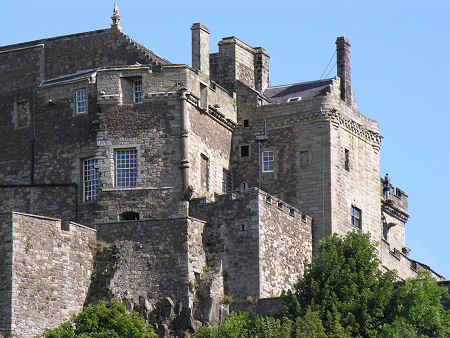 Stirling Castle, Where James II Murdered the 8th Earl of Douglas |
James II lived from 16 October 1430 to 3 August 1460 and was King of Scotland from 21 February 1437 until 3 August 1460. James was the only son of James I and Queen Joan, and at the time of James I's murder at Perth in 1437 he was just six years old. He was known as James of the Fiery Face as a result of a birthmark. The wider picture in Scotland at the time is set out in our Historical Timeline.
James II was crowned in Holyrood Abbey, Edinburgh, so becoming the first King of Scotland not to be crowned at Scone since Kenneth I. James I had been murdered by distant family members challenging his legitimate right to the throne. Queen Joan, had survived the attack and took immediate and dramatic steps to safeguard James II's hold on the throne by wiping out the side of Robert II's family responsible for murdering James I: with a savagery that was remarkable even for the times.
James II spent much of his minority as a pawn caught between rival factions amongst the Scottish nobility, especially between the Douglas family and others including the Crichtons and Livingstons. Whoever possessed James wielded power in the land. A particular low point came when William, 1st Lord Crichton and Sir Alexander Livingston invited the young 6th Earl of Douglas and his younger brother to dine with them and with James II at Edinburgh Castle on 24 November 1440.
At what has become called the Black Dinner, Crichton and Livingston arranged a mock trial of the young Douglases, and despite James' protests, murdered them. The government of Scotland was chaotic in the years until James II assumed power in 1449, though much of the kingdom remained in the grip of the Douglas family. James efforts to regain control culminated in a meeting at Stirling Castle on 22 February 1452 between James and the 8th Earl of Douglas. They argued, and James II drew a dagger and stabbed the Earl, who was then finished off by assorted courtiers.
Over the following five years James was an active and increasingly popular King of Scotland: despite a decree made on 6 March 1457 that that there should be regular archery practice and that "football and golf be utterly cried down and not used".
By 1460 James felt secure enough at home to turn his attention south, and besieged Roxburgh castle, one of the last in Scotland to be held by the English in the aftermath of the Wars of Independence. James II took a personal part in the siege, in which, as an enthusiast for artillery, he used a number of cannons. On 3 August 1460 he was standing next to a cannon at Roxburgh that exploded, giving the king a serious thigh injury. He died from loss of blood shortly afterwards. He was still only 29 years old. James II was buried at Holyrood Abbey in Edinburgh and was succeeded by his nine year old son, James III.
